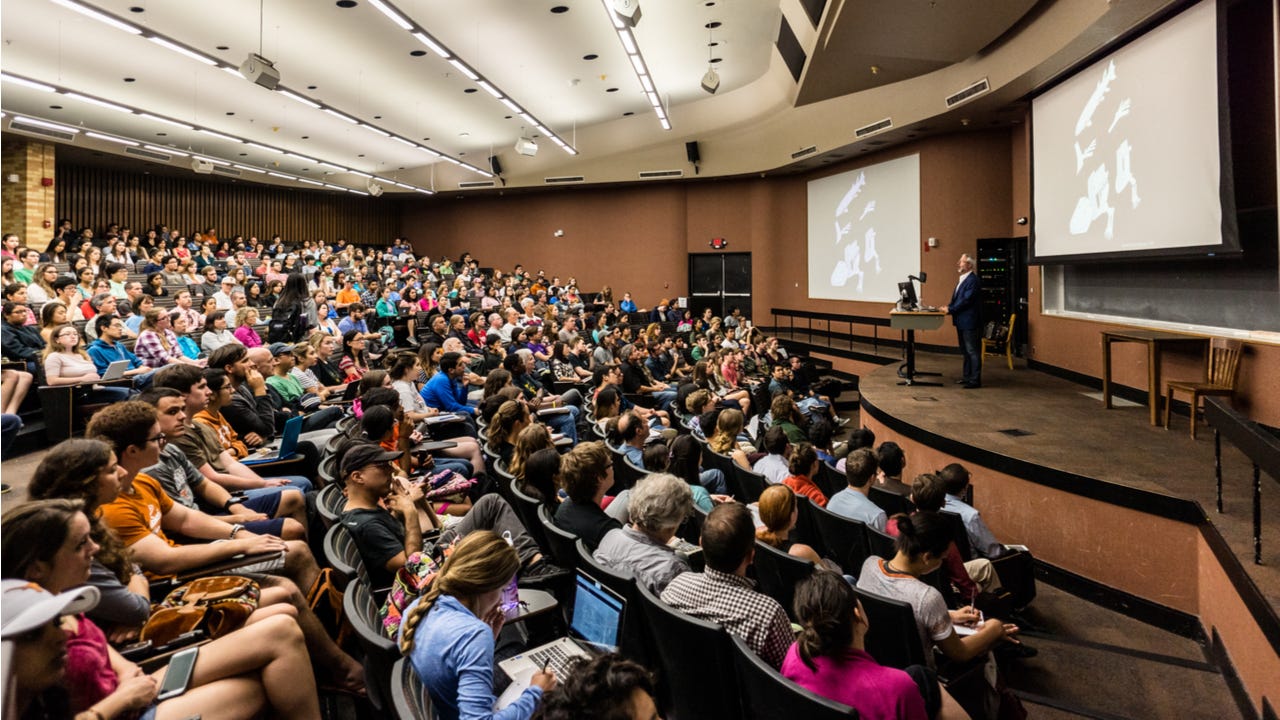College enrollment statistics

The Bankrate promise
At Bankrate we strive to help you make smarter financial decisions. While we adhere to strict , this post may contain references to products from our partners. Here's an explanation for .
More than 25 million students were enrolled in a U.S. college or higher education institution in the 2020-21 school year, according to data from the National Center for Education Statistics. However, data shows that enrollment in the United States has been steadily trending downward for nearly a decade.
According to a NSCRC study, college enrollment has fallen 3.2 percent since the start of COVID-19 in 2020. That suggests a connection between the financial and physical impact of the coronavirus and downward enrollment trends. Plus, as inflation hit tuition rates, a 2021 Citizens survey found that 70 percent of college students cited affordability and student debt as concerns impacting their fall 2021 enrollment plans.
Read on to learn more about the macroeconomic factors contributing to these trends and how demographics have changed among degree-earners.
College enrollment statistics
The National Center for Education Statistics (NCES) tracks college enrollment year over year, breaking down the data by degree type, demographics and more. Here are some highlights from the most recent data, from 2020-21 unless otherwise noted:
- 25,349,502 students in the U.S. were enrolled in Title IV postsecondary institutions.
- 21,361,807 students enrolled were undergraduate students.
- 3,987,695 students enrolled were graduate students.
- 14,974,263 students enrolled were female, up 69.4 percent from the year 2000.
- College enrollment has decreased in recent years, down 14.51 percent from its peak in 2010-11.
- Between the 2019-20 and 2020-21 academic year, male enrollment declined from 10,984,279 to 10,375,239 students.
- In fall 2020, 468,900 undocumented undergraduate students were enrolled, a 25 percent increase from 2009 and 15 percent decrease since the 2019 academic year.
- Total undergraduate enrollment is expected to increase by 8 percent between 2020 and 2030.
- In fall 2020, female students made up 58 percent of undergraduates and males made up 42 percent.
- Between 2020 and 2030, female enrollment is projected to increase by 6 percent and male enrollment is expected to rise by 11 percent.
College enrollment has steadily declined for the better part of a decade, with many choosing to pursue trade schools or join the workforce after graduating high school.
However, while college attendance is on a steady decline, major shifts in enrollment variables such as race, sex and socioeconomic status are anticipated over the next decade, says Joseph Howard, vice president for enrollment at Widener University. He predicts that the average college student within the next decade is more likely to be a student of color or a first-generation student.
The coronavirus is an added variable when it comes to future and present enrollment trends. While the impact of the virus is still playing out, Howard notes that there’s been a steep decline in FAFSA applications. This means that students on the margin of previous enrollment trends — including low-income or first-generation students — may be feeling outsized effects of the strain that COVID-19 has had on higher education.
Enrollment demographics
As of the 15.9 million undergraduates enrolled in a U.S. college or university in the fall 2020 semester, white students made up the largest demographic of students with 8.1 million enrolled. Students who identified as Pacific Islander made up the smallest amount at 42,500. About 3.3 million students were Hispanic, 2.0 million were Black and 107,300 were American Indian or Alaska Native.
All racial and ethnic groups saw declines in undergraduate enrollment in fall 2020 when compared to fall 2019 enrollment numbers. In contrast, during the same years, Hispanic graduate student enrollment increased by 86 percent, Asian/ Pacific Islander enrollment increased by 26 percent and Black enrollment increased by 14 percent.
Trade school enrollment statistics
Applying for a trade school is often much simpler than applying for traditional four-year schools. Students can apply online and will likely need only to provide a high school diploma or GED equivalent to qualify.
Trade school is often cheaper than a traditional degree. However, costs vary by state and school, which can affect financial aid and scholarship opportunities.
- In fall 2021, 76 percent of first-time certification or associate degree-earners admitted to public institutions chose to enroll.
- According to a 2021 survey, 89 percent of contractors reported having a hard time finding qualified construction workers.
- In the 2020-21 academic year, 4,770,477 students were awarded occupation-related certifications.
- Computer, mathematical, health-practice, architecture and engineering-related fields are the highest paying occupations across all education levels.
- There has been a 64 percent growth in apprenticeships since 2012 in the U.S.
- White workers have the highest lifetime earnings across all racial and ethnic groups among those with lower levels of higher education.
- Nearly 400,000 students have completed an apprenticeship within the last five years.
- Due to growing demand, by 2030 260,000 new trade jobs will be available.
Alternatives to college
There are plenty of alternatives for students who don’t wish to attend a traditional four-year institution and the demand only continues to grow for these institutions.
In fact, as of 2021, over 2 million new apprentices have enrolled since 2012 — up 22 percent from the previous 10-year average. Of those, 241,000 enrolled in 2021 alone, while 96,000 graduated from an apprenticeship.
Here are the number of students who were enrolled in the following alternative schooling options in 2020 and how many completed their training within that fiscal year.
| Alternative name | Number of students selecting this path | Number of students who completed their training |
| Occupation-related certification | 269,639 | 185,591 |
| Apprenticeships | 221,000 | 82,379 |
| Military apprenticeship | 122,767 | 17,271 |
| Career bootcamps | 24,975 | 15,619 |
Biggest colleges in the U.S.
The type of institution matters just as much as location when it comes to enrollment numbers. Public schools on the whole have a higher enrollment rate, and public schools top the list of individual institutions with the highest enrollment numbers.
Institution type
The latest available data shows that public college enrollment is more than double that of private college enrollment. Private colleges tend to keep admissions competitive in order to keep class sizes small, which contributes to the disparity in enrollment.
In the 2020-21 academic year, postsecondary institution enrollment broke out as follows:
| Total enrollment | Public enrollment | Private not-for-profit enrollment | Private for-profit enrollment |
| 25,349,502 | 18,241,526 | 5,063,485 | 2,077,130 |
Source: National Center for Education Statistics
Institution
As part of its College Scorecard, the U.S. Department of Education lists total enrollment for institutions across the country. In 2020-21, Southern New Hampshire University took the lead with nearly 110,000 undergraduates.
The top 20 colleges and universities in the U.S. based on undergraduate enrollment for the 2020-21 year are:
| College | Undergraduate enrollment |
| Southern New Hampshire University | 109,233 |
| Western Governors University | 104,919 |
| Pennsylvania State University | 73,189 |
| University of Phoenix | 66,294 |
| Arizona State University Campus Immersion | 62,633 |
| Grand Canyon University | 62,424 |
| University of Central Florida | 61,111 |
| Texas A&M University | 54,942 |
| Ivy Tech Community College | 50,792 |
| Lone Star College | 50,580 |
| Houston Community College | 48,060 |
| Liberty University | 47,432 |
| Dallas College | 45,888 |
| Ohio State University | 45,862 |
| University of Maryland Global Campus | 44,442 |
| Brigham Young University | 43,660 |
| Tarrant County College | 41,369 |
| Miami Dade College | 41,353 |
| Florida International University | 41,220 |
| Arizona State University Digital Immersion | 40,275 |
Source: College Scorecard
Related Articles

Most savings accounts still come with limits on withdrawals even after Regulation D lifted them

What college graduation statistics tell us about higher education

Paying for college in a recession: Statistics and predictions 2024
